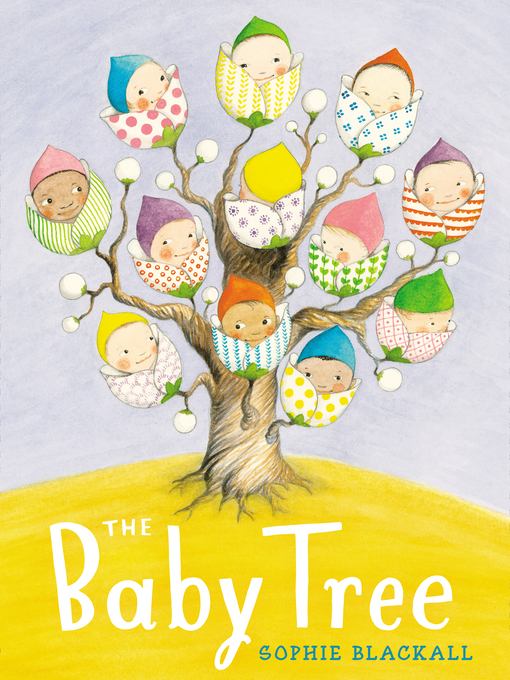
The Baby Tree
فرمت کتاب
ebook
تاریخ انتشار
2014
Lexile Score
540
Reading Level
0-2
ATOS
3.1
Interest Level
K-3(LG)
نویسنده
Sophie Blackallشابک
9780698158108
کتاب های مرتبط
- اطلاعات
- نقد و بررسی
- دیدگاه کاربران
نقد و بررسی

Starred review from March 10, 2014
Blackall once again excels at portraying a thoughtful child with a rich inner life, as her hero/narrator finds his world upended when his parents announce the arrival of a new baby. “I have a hundred questions in my head,” the boy confides to readers, “but the only one that comes out is Are there any more cocopops?” Regaining his bearings, he asks the other adults in his life where babies come from. Their gently evasive half-answers enable Blackall to unleash her special brand of elegant, pokerfaced surrealism; when the kindly but taken aback mailman indicates that he “thinks babies comes from eggs. But he doesn’t know where to get the eggs,” the boy imagines a cozy nest of human baby eggs in various stages of hatching. But Blackall also admires her hero’s inquisitiveness, and the way he squares his parents’ eventual, more scientific explanation with what he’s heard throughout the day (eggs are involved, after all) makes for a lovely tribute to the blossoming mind. An afterword offers helpful narratives for grownups facing a similar line of inquiry. Ages 5–8. Agent: Nancy Gallt Literary Agency.

April 1, 2014
When a small boy learns a baby's coming to his family, he wonders where it's coming from. In words and pictures, the unnamed narrator's imagination builds a variety of possibilities from the pat responses to his query he gets from a teenage friend, a teacher, the mailman and his grandfather. Finally, he asks his parents. Their simple explanation about a seed, an egg and birth in a hospital helps him see that all the other answers (except for Grandpa's story about the stork) were partially right. As she did in Are You Awake? (2011), Blackall captures the natures of children's curiosity and family conversations. Her ink-and-watercolor illustrations include plenty of white space. They show the rosy-cheeked boy engaged in typical kid activities at home, at school and while visiting his grandfather. His question is not burning, but time passes and he gets more and more confused. (And his mother gets visibly pregnant.) The pacing is leisurely and the tone gently humorous, and the answer includes no anatomical details. Modern in its imagery (both parents have smartphones plugged in by the bed), this is just right for initiating a conversation with a 4- to 6-year-old child. A final page for parents covers less typical family situations: twins, adoption and single-sex couples. A gentle, appropriate answer to a perennial question. (Picture book. 4-6)
COPYRIGHT(2014) Kirkus Reviews, ALL RIGHTS RESERVED.

Starred review from April 1, 2014
K-Gr 2-A delightfully age-appropriate way to give young children the facts about conception and birth. A baby is coming, and the soon-to-be big brother has many questions, his most persistent one being "Where do babies come from?" After gathering partial answers from his babysitter, his teacher, and his grandpa, he is more confused than ever. The boy has heard that babies come from a baby tree, the hospital, and special delivery by stork. Feeling dissatisfied with these answers, he finally asks Mom and Dad, who lovingly sit down and explain exactly where babies come from. In one page, they relate the truth, explaining that an egg comes from the mother, a seed from the father, resulting in the growth of a baby-an explanation that satisfies the protagonist's curiosity and makes him realize that there is a bit of truth in every story. Well, except for Grandpa's. He just may have to explain to him where babies really come from. The story smoothly sails from tale to tale as the main character searches for answers. The back matter goes into more detail for children who would like more information. The Chinese ink and watercolor illustrations are beautifully crafted and designed in a manner that shows movement. Each page is adorned with soft colors and crisp, clear pictures that enhance the story. Another wonderful contribution from Blackall.-Amy Shepherd, St. Anne's Episcopal School, Middleton, DE
Copyright 2014 School Library Journal, LLC Used with permission.

May 1, 2014
Preschool-K How does one go about getting a baby? A young brother-to-be ponders that question after learning an infant will be joining his family. He asks a number of people and receives a wide variety of responses, leaving him more confused than enlightened. He finally questions his parents, who tell him what he wants to know, simply and without fanfare. Engaging illustrations in Chinese ink and watercolor vary in size from large double-page spreads to several small vignettes on a page. Each response to the question stimulates the boy's imagination as revealed in the pictures: a stork making a delivery, a baby tree bursting with buds and babies, and infants hatching from eggs in a nest. The characters appear to be vigorously healthy with their florid cheeks and ever-present smiles, and the antics of the family's black cat are entertaining. Answering the Question Where Do Babies Come From?' concludes the book and contains age-appropriate responses. An appealing book for children preparing to welcome a new baby or who are simply curious.(Reprinted with permission of Booklist, copyright 2014, American Library Association.)

























دیدگاه کاربران